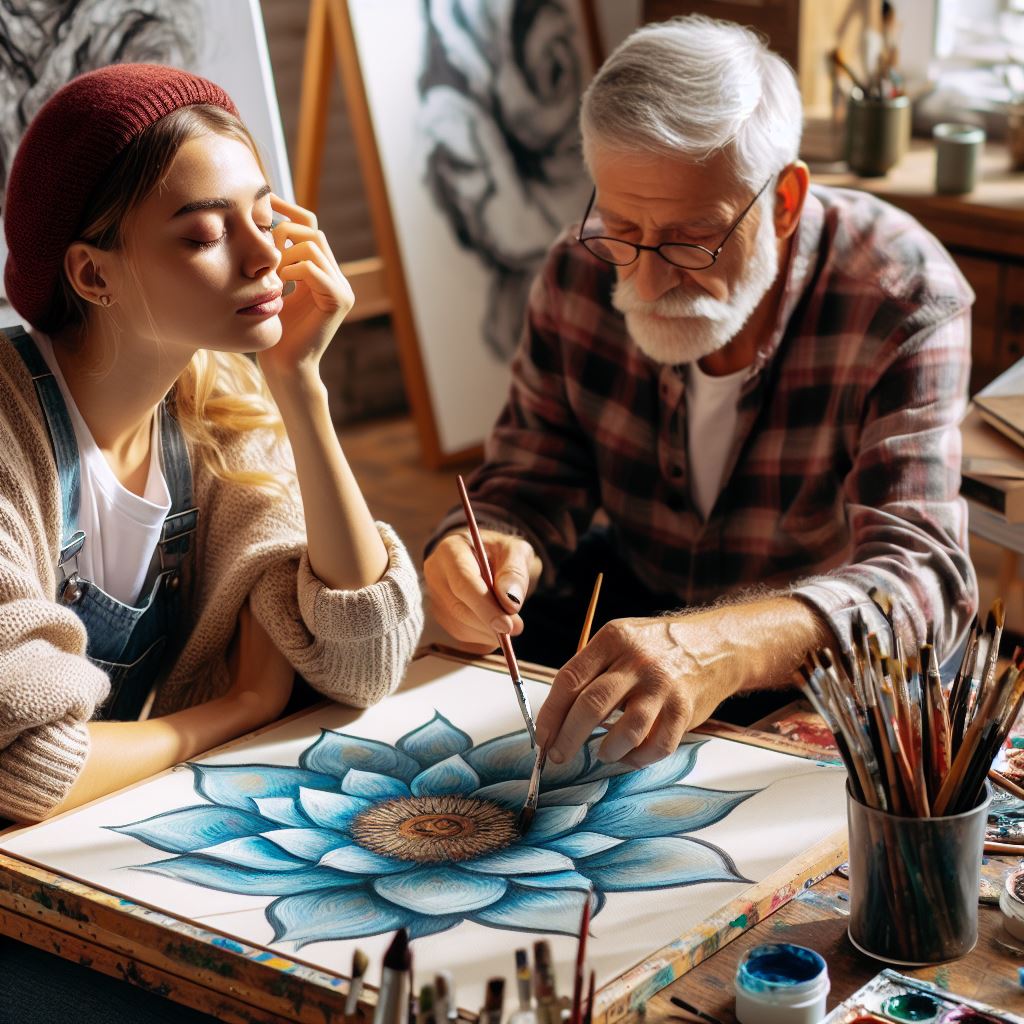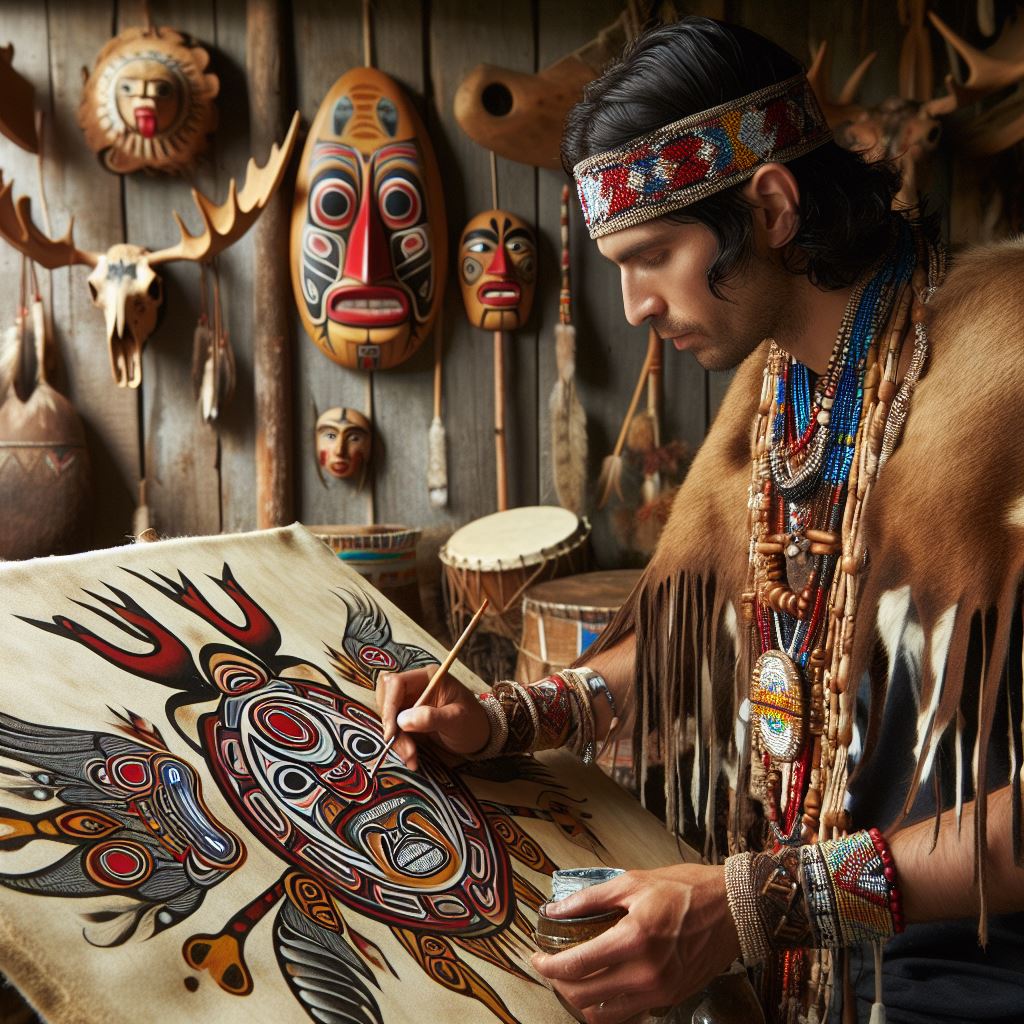Introduction
In this blog post, we will explore the definition and purpose of art collectives, the importance and relevance they hold in Canada, and how they contribute to Canada’s vibrant art scene.
Definition and Purpose of Art Collectives
Art collectives are groups of artists who come together to collaborate, share resources, and create art collectively.
Their purpose is to foster a sense of community, nurture creativity, and promote collective decision-making in the artistic process.
Importance and Relevance of Art Collectives in Canada
Art collectives play a pivotal role in Canada’s art scene.
They provide a platform for emerging artists to showcase their work, enabling them to gain exposure and recognition.
Collectives also offer a supportive network for artists, offering mentorship, shared studios, and opportunities for collaboration.
Overview of How Art Collectives Contribute to Canada’s Art Scene
They are instrumental in shaping Canada’s art landscape.
They organize exhibitions, workshops, and community events, bringing art to wider audiences and fostering cultural exchange.
Collectives also challenge conventional norms and push boundaries, driving innovation and artistic development.
Furthermore, art collectives enable diversity and inclusivity in Canada’s art scene.
They amplify marginalized voices and advocate for social change through their work, addressing important issues and promoting dialogue within society.
Basically, art collectives are indispensable in Canada’s art scene.
They provide a collaborative and supportive platform for artists, promote artistic innovation, and contribute significantly to the cultural fabric of the country.
Historical Background of Art Collectives in Canada
Brief overview of the emergence of art collectives in Canada
Art collectives in Canada have played a significant role in shaping the country’s art scene throughout history.
These collectives emerged as a response to the need for collaboration and shared resources among artists.
During the early 20th century, artists in Canada faced numerous challenges, including limited access to exhibition spaces and financial constraints.
As a result, they began forming collectives to address these issues collectively.
Key influential art collectives and their contributions
- Group of Seven: One of the most influential art collectives in Canada was the Group of Seven, founded in 1920. Comprised of seven landscape painters, the group aimed to develop a distinctly Canadian art style. Their bold and vibrant depictions of the Canadian landscape helped define Canadian art in the early 20th century.
- General Idea: Founded in 1969, General Idea was a conceptual art collective that challenged traditional notions of art and its relationship to society. Their provocative works explored themes of consumerism, mass media, and identity, making them pioneers of the Canadian avant-garde movement.
- CARFAC: The Canadian Artists’ Representation/Le Front des artistes canadiens (CARFAC) was established in 1968. This collective advocated for the rights and fair treatment of visual artists. They played a crucial role in influencing art policies, including the establishment of minimum fees for artists and the protection of their copyright.
Impact of art collectives on shaping the Canadian art landscape
Art collectives have had a profound impact on shaping Canada’s art scene throughout history.
Their contributions include:
- Fostering collaboration and support: Art collectives provided artists with a supportive community, allowing them to collaborate, exchange ideas, and share resources. This collaborative environment facilitated the development of innovative and groundbreaking works.
- Breaking down barriers: Collectives like General Idea challenged societal norms and pushed the boundaries of art. Through their provocative art, they tackled issues such as gender identity, sexuality, and commercialization, challenging the status quo and paving the way for more inclusive and diverse art practices.
- Shaping national identity: The Group of Seven’s depictions of the Canadian landscape contributed to the development of a distinct national identity. By capturing the beauty of Canada’s wilderness, they celebrated the country’s unique cultural heritage.
- Advocating for artists’ rights: Collectives like CARFAC have played a crucial role in advocating for artists’ rights. Their efforts have led to improvements in fair remuneration, copyright protection, and the establishment of standards and guidelines for the art industry.
Essentially, art collectives have played a vital role in Canada’s art scene by fostering collaboration, challenging societal norms, shaping national identity, and advocating for artists’ rights.
These collectives have left a lasting legacy on the Canadian art landscape, influencing future generations of artists and contributing to the rich cultural fabric of the country.
Read: Emerging Art Trends in Canada for 2024-2024
Benefits of Art Collectives in Canada
A collaborative environment for artists
- Art collectives provide a supportive space where artists can collaborate and exchange ideas.
- Artists can pool their resources, skills, and knowledge to create innovative and impactful artworks.
- Through collective work, artists can challenge and inspire each other, pushing the boundaries of their creativity.
- Being part of a collective can help artists overcome feelings of isolation and create a sense of belonging.
- Artists can learn from each other’s techniques, styles, and perspectives, expanding their artistic horizons.
Support and resource-sharing opportunities
- Art collectives often offer mutual support and encouragement, helping artists navigate the challenges of the art industry.
- Artists can share information about grants, residencies, and exhibition opportunities, increasing their chances of success.
- Collectives can also provide access to shared spaces, equipment, and materials, reducing individual costs for artists.
- Members can tap into each other’s networks and connections, opening doors to new collaborations and partnerships.
- By sharing experiences and knowledge, artists in collectives can collectively develop their professional skills and business acumen.
Increased exposure and visibility for artists
- Art collectives often organize group exhibitions, allowing artists to showcase their works to a wider audience.
- Collective shows attract attention from galleries, curators, and art enthusiasts, potentially leading to solo exhibitions or representation.
- By pooling resources, collectives can invest in marketing and promotion, reaching a broader public and potential buyers.
- Collectives can participate in art fairs, festivals, and community events, increasing the visibility of individual artists.
- Through collaborations, artists can tap into each other’s fan base and social media following, expanding their reach.
Stimulating creativity and innovation through collective work
- Art collectives provide a nurturing environment for experimentation and risk-taking.
- Artists can explore new mediums, techniques, and conceptual approaches through collective projects.
- By working together, artists can spark inspiration and challenge conventional thinking, leading to groundbreaking artworks.
- The exchange and critiquing of ideas within collectives foster a culture of constant learning and growth.
- Collectives can serve as incubators for new ideas and collaborative projects that push the boundaries of art in Canada.
In general, art collectives in Canada offer numerous benefits to artists.
They provide a collaborative environment, foster support and resource-sharing, increase exposure and visibility, and stimulate creativity and innovation.
Being part of a collective allows artists to thrive and succeed in the vibrant Canadian art scene.
Unlock Your Career Potential
Visualize a clear path to success with our tailored Career Consulting service. Personalized insights in just 1-3 days.
Get StartedRead: Indigenous Art in Canada: Voices and Visions
Examples of Prominent Art Collectives in Canada
Group of Seven
The Group of Seven, established in the 1920s, consisted of influential Canadian landscape painters.
Their vibrant and bold portrayals of the Canadian wilderness had a significant impact on Canadian art.
General Idea
General Idea, an art collective formed in the late 1960s, focused on conceptual and media-based art.
Their work challenged societal norms and pushed the boundaries of art and its role in society.
Beaver Hall Group
The Beaver Hall Group, active in the early 20th century, was composed mainly of women artists.
They sought recognition and a space to exhibit their works in a male-dominated art scene.
CARFAC
CARFAC, the Canadian Artists’ Representation/Le Front des artistes canadiens, is a national collective.
They advocate for artists’ rights, fair compensation, and improved working conditions in Canada.
Other notable art collectives shaping Canada’s art scene
- En Masse: A Montreal-based collective known for large-scale collaborative murals involving a diverse range of artists.
- Instant Coffee: A Vancouver collective exploring alternative art spaces and encouraging public participation.
- Parkdale Roadrunners: An artist-run collective based in Toronto, focusing on community engagement and social practice.
- Blank Cheque Gallery: A feminist art collective in Calgary, promoting women and non-binary artists in the art scene.
- Art Metropole: A Toronto-based collective that functions as an artist-run center and distribution hub for artist books and multiples.
These examples demonstrate the diversity and influence of art collectives in Canada’s art scene.
Read: Balancing Art and Business: Tips for Canadian Artists
Challenges and Criticisms Faced by Art Collectives
Difficulties in decision-making and consensus-building
- Art collectives often face challenges in making decisions due to the diverse opinions within the group.
- It can be time-consuming and challenging to reach a consensus when multiple voices and perspectives are involved.
- The decision-making process may require compromise and negotiation to ensure everyone’s input is valued.
- Disagreements and conflicts can arise, affecting the overall cohesion and functioning of the collective.
- Successful navigation of decision-making challenges is crucial for the collective’s growth and progress.
Balancing individual artistic identities with collective goals
- Artists in collectives often have their unique artistic styles, identities, and creative visions.
- However, they need to find a balance between expressing their individuality and working towards the collective’s goals.
- Negotiating this balance requires understanding and respecting each member’s artistic voice within the collective.
- Recognizing and utilizing the diverse skills and perspectives of the artists can enhance the collective’s overall artistic output.
- When successful, art collectives can create a cohesive body of work that reflects both collective and individual artistic identities.
Funding and financial sustainability issues
- Art collectives often face funding challenges, especially in securing long-term financial sustainability.
- Relying on grants, sponsorships, and donations is common, but it requires ongoing effort and resourcefulness.
- Collectives need to develop effective fundraising strategies and continually seek opportunities to sustain their activities.
- Financial stability is crucial for organizing exhibitions, funding art projects, and supporting collective members.
- Without sustainable funding, art collectives may struggle to maintain momentum and achieve their artistic goals.
Criticisms regarding exclusivity and lack of diversity in some collectives
- There are critiques about certain art collectives being exclusive and limited in their representation of diverse voices.
- Some collectives may have predominantly white, male, or privileged members, overlooking other marginalized artists.
- This criticism underscores the importance of creating inclusive and diverse art communities.
- Art collectives should actively strive to embrace diversity, inclusivity, and equal representation of artists.
- By diversifying their membership and supporting underrepresented artists, collectives can enrich the Canadian art scene.
Read: Art Therapy: A Growing Trend in Canadian Wellness

Impact of Art Collectives on Canada’s Art Scene
Enhancing cultural identity and national pride
Art collectives play a vital role in Canada’s art scene by promoting cultural identity and national pride.
Through their collaborative efforts, they showcase the diverse perspectives and talents of Canadian artists.
By highlighting the unique cultural heritage of different regions, they help Canadians connect with their roots and develop a sense of belonging.
They celebrate indigenous art, immigrant experiences, and the stories of marginalized communities, fostering a deeper understanding of Canada’s rich cultural tapestry.
Furthermore, they often organize events and exhibitions that celebrate national symbols and iconic Canadian subjects.
This strengthens the connection between art and national pride, encouraging Canadians to take pride in their artistic heritage.
Fostering artistic expression and experimentation
Art collectives provide a supportive environment for artists to explore their creativity and experiment with new ideas.
They encourage artists to push the boundaries and challenge traditional norms, resulting in innovative and thought-provoking artwork.
Through collaboration and collective brainstorming, artists within these collectives inspire each other and share knowledge, expanding the possibilities for artistic expression.
This dynamic exchange of ideas fosters a vibrant and progressive art scene in Canada.
Moreover, they often provide resources, such as art studios and materials, that individual artists might not have access to.
This enables artists to fully immerse themselves in their craft and pursue ambitious projects that would otherwise be unattainable.
Shaping public discourse and social consciousness
Art collectives have the power to shape public discourse and raise awareness about important social issues.
Through their artwork, they provoke conversations, challenge societal norms, and promote critical thinking.
By addressing timely topics like gender equality, racial justice, and environmental concerns, they contribute to a more informed and socially conscious society.
They amplify marginalized voices, influencing public opinion and catalyzing social change.
Art collectives also organize community engagement initiatives, such as workshops and public art projects, to foster dialogue and create inclusive spaces for meaningful conversations.
These initiatives help bridge gaps between different communities and contribute to a more interconnected and empathetic society.
Influencing art institutions and the market
Art collectives have a significant impact on art institutions and the market in Canada.
They provide alternative platforms and spaces that challenge the dominance of traditional galleries and museums.
By organizing independent exhibitions, pop-up shows, and public installations, they create opportunities for emerging and underrepresented artists to showcase their work.
This diversifies the art scene, exposing viewers to a wider range of artistic styles and perspectives.
Moreover, art collectives often collaborate with galleries and museums, influencing their curatorial decisions and programming.
They bring fresh, avant-garde perspectives that push institutions to embrace more experimental and unconventional artwork.
In terms of the market, they often create their own avenues for selling artwork, bypassing traditional commercial structures.
They organize art fairs, online marketplaces, and auctions that prioritize supporting local artists and fostering a sustainable art economy.
In essence, they have a profound impact on Canada’s art scene in terms of enhancing cultural identity, fostering artistic expression, shaping public discourse, and influencing art institutions and the market.
Through their collaborative endeavors, they contribute to a vibrant and inclusive artistic landscape in Canada.
Uncover the Details: Home Studios: Setting Up in Canada
Future Outlook for Art Collectives in Canada
Evolving trends in the art collective landscape
- Increased collaboration and interdisciplinary approaches becoming more prominent in art collectives.
- Shift towards alternative and non-traditional spaces for exhibitions and art events.
- Growing emphasis on inclusivity, diversity, and social justice initiatives within art collectives.
- Rise of sustainable practices and eco-friendly approaches in art production and curation.
- Incorporation of technology and digital platforms to expand reach and engage audiences.
Opportunities and challenges in the digital age
- Access to a global audience through online platforms creates new opportunities for exposure and exchange.
- Virtual exhibitions and digital artwork sales offer convenient ways for artists to showcase and sell their work.
- Digital art collectives face challenges in establishing trust and authenticity in an online environment.
- Digital divide and technological barriers may limit accessibility and participation in art collectives for some artists.
- Copyright and intellectual property concerns arise with the ease of digital reproduction and distribution.
Potential for art collectives to adapt and address societal changes
- Art collectives can play a crucial role in fostering dialogue and addressing pressing social issues.
- Ability to provide support and resources for artists facing financial and systemic barriers in the art world.
- They can act as catalysts for community-building and strengthening local art scenes.
- Engagement with the public through interactive projects and community outreach initiatives.
- Opportunity for art collectives to advocate for arts funding, policies, and infrastructure at the government level.
In a nutshell, the future outlook for art collectives in Canada is both promising and challenging.
The evolving trends in the art collective landscape demonstrate a shift towards collaboration, inclusivity, and sustainability.
The digital age presents opportunities for global exposure and innovative approaches to curating and selling artwork.
However, challenges such as trust-building in the online realm, accessibility barriers, and copyright concerns need to be addressed.
Despite these challenges, they have the potential to adapt and address societal changes by fostering dialogue, supporting artists, strengthening communities, and advocating for the arts.
By embracing these opportunities and addressing the challenges, they can continue to play a vital role in Canada’s vibrant art scene.
Delve into the Subject: Creative Spaces: Top Canadian Art Studios to Know
Conclusion
Art collectives have played a significant role in Canada’s art scene.
They have provided a platform for artists to collaborate, share ideas, and create impactful works of art.
The contributions of art collectives are invaluable, and it is essential to support and appreciate their efforts.
Artists who join art collectives can benefit from the shared resources, knowledge, and experience of other members.
Joining an art collective can also provide opportunities for artists to showcase their work, network with other artists, and gain exposure.
Generally, art collectives are a vital part of Canada’s art scene, and their contributions should be celebrated and supported.
Artists should explore the benefits of joining art collectives and take advantage of the opportunities they provide.
By doing so, they can enhance their skills, expand their horizons, and contribute to the growth and development of Canada’s art scene.




